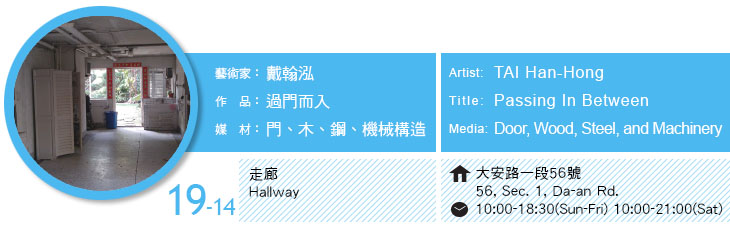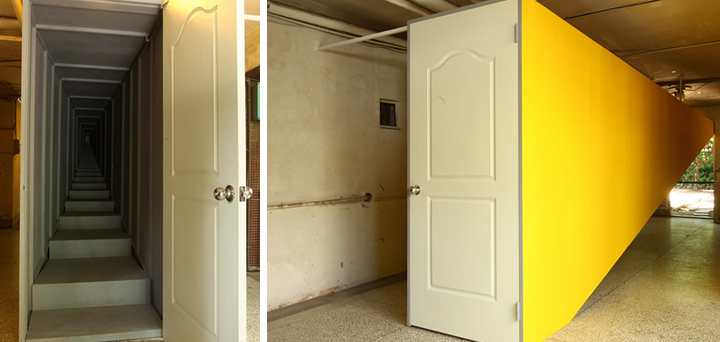









| 岩崎崇 | 張子隆 | ||
| 林怡芬 | 許旆誠 | ||
| 瑪莉娜克魯斯 | 張永達 | ||
| 朱盈樺 | 劉文瑄 | ||
| 大江慶之 | 戴翰泓 | ||
| 袴田京太郎 | 黃柏勳 | ||
| 似不像 | 杜珮詩 | ||
| 鍾舜文 | 賴易志 | ||
| 鄭秀如 | 楊‧弗門 | ||
| 游文富 | 海蒂‧渥特 | ||
| 黃彥超 | 池田朗子 | ||
| 康雅筑 | 徐薇蕙 | ||
| 劉瀚之 | 黃華真 | ||
| 宇治野宗輝 | 鍾順龍 | ||
| 澤拓 | 李佳祐 | ||
| 游文富 | 戴翰泓 | ||
| 瑪格妲‧賽耶 | 澤拓 | ||
| 陶亞倫 | 徐永旭 | ||
| 徐瑞憲 | 豪華朗機工 | ||
| 蔡筱淇、吉川公野 | 劉小康 | ||


| 作品承重1次限1人,敬請排隊等候 Capacity: 1 person at a time. Please line up and wait for your turn |
建築研究的背景反映在戴翰泓的創作之中,透過實驗「界線」觀點,藝術家以裝置或雕塑等媒材來表現實境,並加入互動元素,由觀者的身體親歷做為作品完成的最後一道工法。 穿越的廊道空間,引領著人們進去與離開;於此之外,它是否還能穿越其它維度介面?孰悉尺寸的入口,連結著微小的陌生世界;進入其中,正常的身軀卻將顯得過大,也因此爬樓梯這樣簡單的動作卻遇到了現實的「瓶頸」… 「現實在夢中已死,而夢存在於現實之中…當不用打開門就可穿越一個面,那麼打開門後的那個世界或維度空間將被稱作什麼?我在現實,打開了夢境和現實世界穿越同一介面的小門……」 戴翰泓的作品頑皮地改變了既有建築與空間結構,企圖藉觀者身體姿態經歷的變化,去連結對於空間感覺與邏輯的思緒轉換。 |
As a final touch, he finishes his pieces with an element of interaction that encourages viewers to experience them through physical movement. “Even though reality dies in dreams, dreams are still found in reality…What is that world we can move in and out of, without opening the door? The truth is I have opened the door that connects dreams and reality.” Tai playfully alters the existing architectural structure that compels viewers to move in unfamiliar ways, inspiring new spatial and logical perception. |
